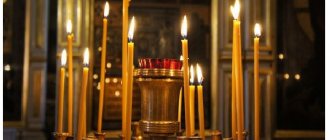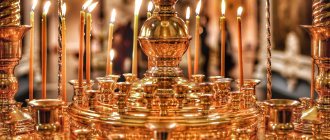All candles used in church use are conventionally called “church candles.” The traditional recipe for their manufacture is to use beeswax without dyes or impurities. Even visually they differ from those candles that are commercially available - a slight smell, a matte yellow tint. The deacon's candle (oslopnaya), the tallest and thickest, has a conical cut at the top and a dense wick. Used during the Liturgy, incense, and reading the Gospel. Another type of church candle is the chandelier. It is the brightest and is translated as “many candlestick”. There is even a position in the church associated with this attribute - candid burner. This includes the monastery minister who is responsible for lighting the candles.
What material is used to make church candles
The dense and rich aroma of real church candles is an attribute of visiting a church, just like the smell of incense. It is not always possible to find real wax products in a church shop, since they often sell candles made of paraffin or stearin. They are more economical to produce and cheaper, but they are strikingly different from candles made by hand. Paraffin candles do not have a unique honey smell, and the matte dark yellow texture is achieved thanks to artificial dyes.
Original wax candles are made in workshops at monasteries by the hands of the monks themselves or parishioners. The production has an important educational effect: often the masters there are lay people, whose past had sad addictions (alcoholism, drugs). Thanks to good work, they come to God and find their place in the world. Candle production at monasteries generates income, which subsequently goes to the maintenance of the monastery itself. This practice is widespread, even in the New Athos Monastery in Abkhazia.
For classic church candles, only natural beeswax is used. It is manually cleaned by monks or candle workshop workers. Such products are highly valued, because the material is not cheap, and a lot of effort goes into manufacturing.
Simple modern candles for churches are made from artificial materials. These are, most often, petroleum products, namely:
- Ceresin is a mineral wax with a melting point of 60-80 degrees. Has no smell.
- Paraffin is a mineral wax, a derivative of petroleum. Melting point from 45 degrees.
- Stearin is a fatty wax, a derivative of stearic acid mixed with other fatty acids. Melting point from 53 degrees.
- Polyethylene wax is a synthetic component with a high melting point (about 100 degrees), which increases the durability of the finished product.
In the industrial production of church candles, a mixture of these components is used. The composition contains paraffin, the rest of the ingredients help the candles stay intact longer and not melt. Modern candles burn slower than traditional candles. To achieve the familiar yellow color and honey smell (to cover the chemical smell of petroleum products), a large number of flavors and dyes are added to such raw materials. Such a candle cannot be called natural, although in the physical sense it produces the same flame as a wax candle.
Bees honey wax is a completely different matter. This material is of high value for candle production. The first wax candles began to be made relatively recently in the historical paradigm. Until the 16th century, lard was used in Rus', that is, they made fatty products that smoked heavily, melted quickly and smelled unpleasant.
Spiritual meaning of a church candle
Both the holy apostles and the first followers of Christ lit candles when they gathered at night to preach the word of God, pray and break bread. On the one hand, this was due to the fact that Christians, persecuted by pagans, retired to dungeons and catacombs for worship; moreover, services were most often performed at night, and it was impossible to do without lamps. But there was another reason why Christians lit candles - it was caused by spiritual necessity: according to St. Sophronius, Patriarch of Jerusalem (VII century), “lamps and candles are an image of eternal light, and they also mean the light with which the righteous shine.” .
The candle has several spiritual meanings. Since it is bought, it is a sign of a person’s voluntary sacrifice to God and His temple, an expression of a person’s readiness to obey God (the softness of the wax), the warmth of our prayer (the burning of a candle). A candle is a testimony of faith, a person’s involvement in the Divine light. A burning candle is a symbol of our ardent love and goodwill towards the one to whom it is placed. And if there is no this love and favor, then the candles have no meaning and our sacrifice is in vain.
I would like to draw special attention to the fact that you cannot light candles while asking the Lord or the saints for something sinful. One young man said: “On the day when my future wife went to have an abortion, I went into the church and lit a large candle for her health in front of the icon of the Virgin Mary. How it twisted and bent my candle! Then I straightened it, but it became warped again. And no matter how I tried to straighten her, she fell and then bent over again...”
An even more amazing incident, proving how displeasing our candles, placed with a sinful request, can be to God and His saints, occurred in the last century on the eve of the revolution. This story was repeatedly described in books about St. Nicholas the Wonderworker.
During the Russo-Japanese War, one soldier was treated in the hospital. One day, the nurse who was caring for him asked him: “What did you do before the war?” And the soldier said quite frankly: “I didn’t do anything. I was lazy. But you need to eat. That's why he was involved in theft. Yes, I got so used to my craft that I yearned for more.
“I once spotted,” the soldier continues to tell, “near Petrograd the suburban dacha of a rich man. Late at night, I decided to sneak through the open window and take all the jewelry. But before carrying out the theft I had planned, I went to the church of St. Nicholas, placed a large candle in front of the icon and said: “St. Nicholas, help me...”.
A bright moonlit night has arrived. I made my way to the dacha. The guards didn't notice me. In the moonlight I saw a wardrobe. Luckily for me, there was a bunch of keys hanging in the door. I took the gold and silver things and began to climb down the rope ladder. When I was going down, suddenly things started clanking in my bag! This ringing woke up the owner. When he saw the loss, he raised the alarm: he ordered the watchmen to saddle their horses and rush after the thief. The watchmen drove through the forest, drove out into an open field and saw something black in the distance. It was a moonlit night - everything was clearly visible. The watchmen headed towards this darkening object.
Meanwhile, the soldier also ran out into the field. He saw some blackening object in the distance and rushed towards it. He came closer and there was a dead horse lying in front of him. The thief stopped in front of the carrion. And suddenly the great miracle worker himself, St. Nicholas, appears in front of him in radiance, in full bishop’s vestments, and says to the robber: “Get into the belly of this horse, otherwise the horsemen are approaching, they will grab you and kill you!” The thief instantly climbed into the stinking carrion. I sat there, choking on the stench. And the guard’s riders are already right there! The horses circle around and find no one. And they turned back. And when they left, Saint Nicholas again appears to the thief in full bishop’s vestments, so that this robber would be convinced that in front of him is not an ordinary person, but a great Wonderworker.
-– Get out of the horse! - said Saint Nicholas.
The thief, of course, happily carried out the saint’s order, as he almost suffocated from the stench.
- Was it good for you to sit there? – the Wonderworker asked the thief.
-– How good! I barely made it out alive! I thought I would suffocate from the unimaginable and terrible stench!
Saint Nicholas answered him:
- That’s how your candle made a stench! You thought that she was pleasing to me, but your candle stank!..”
According to Saint John of Kronstadt,
“It is good to place candles in front of icons. But it is better if you sacrifice to God the fire of love for Him and your neighbor. It’s good if both happen together. If you light candles, but do not have love for God and your neighbor in your heart: you are stingy, you do not live peacefully, then your sacrifice to the Lord is in vain.”
Candles and lamps by themselves, without faith, mean nothing. They will not save us if we ourselves do not care about it; they will not bring mercies from God if we do not love Him and our neighbors. All prayers and all sacrifices will be rejected by the Lord if we have evil against someone or are in enmity with someone. This is what the Savior said: “If you bring your gift to the altar, and there you remember that your brother has something against you, leave your gift there before the altar and go, first make peace with your brother and then come and offer your gift.” (Matt. 5:23–24).
Unfortunately, there are many superstitions associated with candles. Some people believe that the candle should only be passed with the left (right) hand. Newlyweds unjustifiably believe that a candle going out during the wedding means an unhappy married life. These confusions and doubts are inspired only by the devil. You should not trust such false opinions, which, unfortunately, can spread in the church environment. “Don’t believe, and it won’t come true,” said the holy fathers.
If on the day of a major holiday a minister or temple worker extinguishes your candle to light another one, do not be upset: your sacrifice has already been accepted by God. You should not be embarrassed by the different prices of notes or candles. Different prices only mean different amounts of donation for temple needs.
Separately, it should be said about candles “from the street”. “From a church point of view, those who buy candles from street vendors or in secular stores, not in church, sin,” says Deacon Andrei Kuraev.
– If a candle is a symbol of our burning towards God and our sacrifice for Him, then what happens if you purchased this candle from an ordinary businessman? The candle does not pray for us, instead of us. The candle only reminds us of the prayerful burning that should be in our hearts. A candle today is not a way to illuminate a temple or apartment. This small sacrifice itself is a symbol of the greatest sacrifice that a Christian must offer to God: “We will give ourselves and each other and our whole life to Christ our God.” Is it really possible to say this prayer with a stolen candle in your hand? Such a sacrifice is not brought to the temple, but past the temple. And such a candle burns not for God, but for our selfishness and cheap “savings.” A candle bought on the street and brought to the temple is not a sacrifice, but something the opposite. This is a penny stolen from the temple. No matter how the street candle sellers assure that their candles are “Sofrinsky”, “sanctified”, “church” - they offer their interlocutors complicity in sin.
Yes, in the past people brought their candles to the temple, rather than purchasing them in the temple. But even if a small sacrifice - a candle, in order to cease to be an act of purchase and sale and acquire a spiritually significant character, it must still be sacrificed in the temple, and not given to street speculators ... "
You can applaud the author (at least 10 times)32
How are candles made?
The whole process begins with selecting the right wax. Workshops usually purchase beeswax from nearby beekeepers. Each workshop chooses how automated the process will be and what quality of wax they need. Wax briquettes can be round, rectangular, or irregular in shape. In whatever form the beekeepers brought, these briquettes are used for work.
The first stage is always cleaning the wax from impurities. The remains of bees, pieces of propolis, and other bee products can only interfere with production. Such candles will be irregular in shape and may smoke heavily. If the workshop has a special cleaning machine, then the wax is cleaned in it. In more traditional production, the wax is melted and then repeatedly strained through a fine sieve, which traps debris.
In the 21st century, you can no longer find places where candles are made entirely by hand. The use of machines speeds up the process and simplifies the work of craftsmen. Even in monasteries with centuries-old history, there are now specialized machines that automate the longest and most labor-intensive stage (dipping the wick into molten wax).
But before this, the purified wax is molded into briquettes for further work. Experienced craftsmen can already determine by eye what size briquette will be used to make the required number of candles. The wax is re-melted and then placed in a special container inside the machine.
Next comes the stage of working with the wick. For this purpose, production facilities have special frames - cassettes. These cassettes come in different sizes. A wick thread is wound around them according to the number of future candles. In traditional workshops, the wick is wound onto a cassette manually, while modern ones also have special machines for this. What happens next is:
- the cassette is dipped into molten wax;
- after a few seconds it is removed;
- wait until the wax dries;
- the cassette is lowered back into the raw material;
- the process is repeated until the candles acquire the required thickness. For ordinary thin candles, 5 dippings will be enough, but thick altar candles need at least 40 times.
When the candles have reached the required thickness and are completely dry, they are cut depending on the required size. For slicing, use a hot, sharp knife (or a tape cutter in an automatic machine). The wick cassette frames are cleared of wax and the process starts again.
The smallest church candle is 14.5 cm. There can be up to 700 pieces in a 2 kilogram package. It is in kilograms that candles are shipped when sold.
What did the holy fathers say about church candles?
Photo: Flickr.com
If you look at the Apostolic Canons numbered 72 and 73, you can see that already in the first centuries of our era wax candles were used in services, for theft of which they were excommunicated from church communion and were required to pay damages fivefold. In the 15th century, Bishop Simeon of Thessalonica said that only wax candles should be used during services. He explained it this way: wax, as a pure natural substance, symbolizes sincerity of thoughts, the bendability of candles symbolizes readiness to repent, and their fragrance symbolizes the grace of the Holy Spirit. Before the revolution of 1917, the Holy Synod ordered the use of only candles made of pure beeswax. And now they are preferable.
( 8 ratings, average: 3.88 out of 5)
What is the difference between wax and paraffin candles?
You can visually distinguish a real candle made using the old method from a paraffin analogue. Paraffin, even tinted, has a certain translucency, while a wax candle is uniformly yellow, with a dense texture. There are also differences at the level of smells. Even after using fragrances, paraffin does not produce a very natural odor when melted. It is impossible to confuse it with the natural honey aroma of melting wax. Wax candles, even in their untouched state, smell like good and natural flower honey.
Paraffin and wax also feel different to the touch. Wax is more flexible. Try bending a wax candle. It will most likely give in to your attempts, while the paraffin will crack and crumble.
But the most important difference is environmental friendliness and safety. When burned, a paraffin candle does not melt, but evaporates. It is not recommended to breathe such vapors for a long time. And wax products, when burned, flow down in droplets. This causes its own difficulties regarding how to protect the space in the church from melting wax, but it does not harm the atmosphere.











